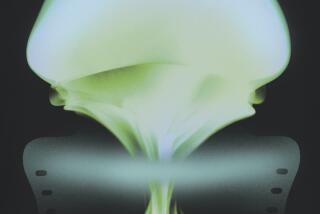Albert V. Crewe dies at 82; physics professor captured first image of an atom
Albert V. Crewe, a physics professor who captured the first image of a single atom and later obtained the first images of atoms in motion, has died. He was 82.
A former director of Argonne National Laboratory near Chicago, Crewe died Nov. 18 of complications from Parkinson’s disease at his home in Dune Acres, Ind., a University of Chicago spokesman said.
Crewe’s breakthrough image of an atom was taken in 1970 with a scanning transmission electron microscope of his own invention at the University of Chicago, where he taught until 1996.
The uranium and thorium atoms that Crewe captured were magnified 1 million times. It was a significant breakthrough -- an atom is incredibly tiny, approximately 4 billionths of an inch in diameter. The event was met with quiet satisfaction by Crewe and his colleagues.
“It wasn’t one of those things where we went around giving each other high-fives,” said Roger Hildebrand, professor emeritus of physics at the University of Chicago.
“He took out a cigar and he lit it up,” said Michael Isaacson, who was a doctoral student when he worked with Crewe.
Jennifer Crewe, who was a middle-school student at the time, said her father came home that night and told the family of his accomplishment. She announced the news to her science class the next day, well before it hit the news.
“Impossible,” her teacher declared.
Crewe made it possible with an idea that came to him on an airplane trip, the University of Chicago said. His powerful microscope scanned a beam of electrons across an object. The electrons scattered and were used to generate an image on a device that converts electrical impulses into pictures.
The next step was to capture the movement of atoms, which Crewe did in 1976 by stringing together a series of still photos that showed atoms were shaky little particles in constant motion.
Born Feb. 18, 1927, Crewe grew up in Yorkshire, in northern England, the son of an auto mechanic. He attended the University of Liverpool, where he received his doctorate and met his wife while with a group of students harvesting the postwar wheat crop.
He moved to Chicago in 1955 to work on a new cyclotron accelerator built by Enrico Fermi and Herbert Anderson. He moved to Argonne in 1958 and was the laboratory’s director from 1961 to 1967. He returned to the University of Chicago and was dean of physical science from 1971 to 1981.
Besides his daughter Jennifer of New York City, Crewe is survived by his wife of 60 years, Doreen; two other daughters, Sarah of Ruidoso, N.M., and Elizabeth of LaGrange, Ill.; a son, David of Sunnyvale; a half-brother, Terrence Crewe; and 10 grandchildren.
More to Read
Sign up for Essential California
The most important California stories and recommendations in your inbox every morning.
You may occasionally receive promotional content from the Los Angeles Times.








